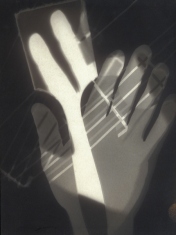For this first task, I’ve decided to focus on seeking abstract shapes, which resemble letters of the alphabet in nature.

Composition VI. Wassily Kandinsky. 1913
‘Abstract art, the pretended autonomy and absoluteness of the aesthetic emerged in a concrete form’ (Schapiro, 1937). To gain more knowledge on this art form, I choose to research the Bauhaus movement and Moholy Nagy, a painter/ photographer and known Bauhaus professor. Griffith Winton (2007) discusses in an online article that Walter Gropius founded the Bauhaus in 1919 in the city of Weimar, with its ‘core objective being a radical concept: to reimagine the material world to reflect the unity of all arts.’ Artists such as Moholy Nagy and Kandinsky, two of the schools renowned faculty members, both believed in the reproduction of old formulas and experimenting with vision. Haase (2005) discusses how Kandinsky used metaphoric concepts consisting of the metaphoric concept of ́spirituality ́, ́geometry ́ and ́emotionality ́. He then goes on to say, Kandinsky wrote that the artists had an ‘inner necessity’ to express the ‘inner essence of things’. He believed colour evoked emotion and that along with other formal elements like lines, shapes and forms, colour is a language that communicates to all. One of his paintings which portrays this perfectly being ‘Composition VI. 1913 ‘.

Photogram 1926. László Moholy–Nagy
When looking for naturally occurring letters and deciding how to contextualise it, I should consider its form and colour to understand the emotion being communicated. As well as experimenting with light and colour, I need to look closely at form. Something Moholy Nagy has shown through his Photograms. For example, Photogram (1926) explores the brightness of the objects silhouette. It has however successfully created an abstract and polysemic piece. In fact here he is only using something as simple as his hands and a paint brush.
For this task my aim is to look closely at the outside world, not only focusing on the small and close up details but the forms as a unity. I hope to take inspiration from Moholy Nagy when opening my mind to encourage various perceptions.
References:
Schapiro, M. (1937). Nature of abstract art. American Marxist Association.
Griffith Winton, Alexandra.(2007). “The Bauhaus, 1919–1933”. In Heilbrunn Timeline of Art History. New York: The Metropolitan Museum of Art, 2000–http://www.metmuseum.org/toah/hd/bauh/hd_bauh.htm
Haase, F. A. (2005). ‘My colorful lexicon’: Synesthesia and the production of metaphors or’Is reading synesthetic’. A Parte Rei: revista de filosofía, 39.
